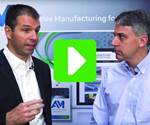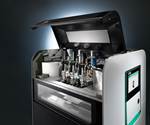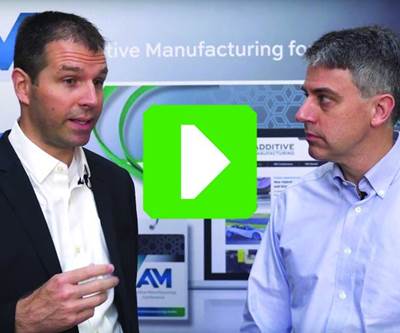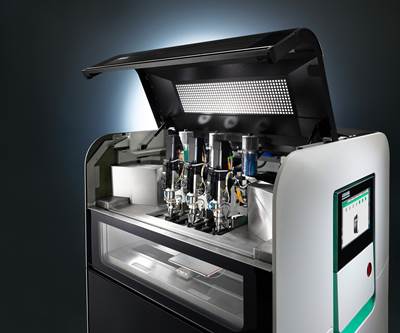3D Printing Fills Gap for Biocompatible Materials
With the Arburg Freeformer, the Aesculap division of medical company B. Braun has recently ramped up its high-volume AM production activities. This is because, particularly in medical technology, the main focus is on options such as the processing of biocompatible materials.
When Hans Keller talks about knee or hip implants, surgical instruments, products for neurosurgery or minimally invasive product concepts, you can virtually feel his passion, which doesn’t stop with the products Aesculap makes with its 3,600 employees in Tuttlingen (the Braun Group employs 70,000 people in 64 countries and sells a total of 5,000 different medical products). His passion extends to technology: machine tools, EDM, additive manufacturing technology (the company currently runs 18 AM machines for both metal and plastics printing), moldmaking equipment and automation.
When Keller, who is director of research & development production at Aesculap, saw Arburg reveal its new large Freeformer 300-3X at Formnext 2018 in Frankfurt, Germany, he immediately decided to become Arburg’s first customer for this bigger machine, which offers nearly 50 percent more build space than the Freeformer 200-3X Aesculap has been running since 2017.
Cost-Efficient Medical 3D Printing
“For a medical company like Aesculap, the Freeformer offers significant advantages, including the processing of original certified materials (for example, medically-approved, resorbable PLLA); the high quality of the parts produced owing to extremely small layer thicknesses; or the option of manufacturing hard/soft combinations,” says Keller, who has more than 25 years of experience in additive manufacturing.
Aesculap installed its first AM machine (a stereolithography printer) in 1993, and today uses various machines and systems, from Objet, EOS, 3D Systems, Concept Laser/GE Additive, Arburg and Prodways. Additive manufacturing at Aesculap covers a wide range of applications, including individual three-dimensional patient templates, training models for surgery, and measurement programs for high-volume parts. These are complemented by additively manufactured parts for rapid prototyping and series production, as well as the development of patient-specific geometries, e.g. specialized knee implants for extraordinarily tall people such as basketball players.
At the end of the day, much in medical technology comes down to costs; the Freeformer can process standard plastic materials also used for injection molding, which considerably reduces costs.
To ramp up his shop’s high-volume production activities, Keller invested in an Arburg Freeformer in 2017. The machine’s ability to produce biocompatible materials, its cost efficiency and the quality of the 3D-printed parts which are ready for immediate use make it the perfect fit. “At the end of the day, much in medical technology comes down to costs, for example in the case of specially adapted bone components and implants, which are in ever-greater demand for individualized patient treatment,” Keller explains. “For this purpose, medical products such as sawing templates and trial implants can be custom built from plastics.”
Sawing templates are 3D-printed as end-use parts and as prototypes before series production (the templates are then made out of metal, milled and wire-cut). Other prototypes made on the Freeformer are handles for medical instruments, which are later produced on an injection molding machine. Around 20 percent of the print jobs on the Freeformer are prototypes, followed by jigs and fixtures (40 percent) and series production (40 percent).
According to Keller, some special plastic materials the company processes on its other AM machines cost up to 400 euros per kilogram, while the Freeformer can process standard plastic materials also used for injection molding, which can be about only eight euros per kilogram, a huge difference.
However, the industrial additive manufacture of functional parts is highly demanding. In addition to a wide range of original materials, material and color combinations, it also requires high part quality and strength. Individual settings options are also needed during the manufacturing process.
Open System Offers Material Freedom
That's why Arburg developed the Arburg Plastic Freeforming (APF) platform specifically as an open system. In comparison with other standard processes on the market, it is possible to optimize the quality and strength of additively manufactured parts using APF, depending on the specific material employed, Arburg says. With the Freeformer, all the process parameters are freely programmable—from the settings for geometrical slicing, to positioning of the droplets and temperature, to discharge. This great freedom, however, requires a structured procedure for qualifying materials and determining pre-optimized process settings to guarantee a reproducible additive manufacturing process.
Users can use the open Freeformer system to optimize droplet size and to process their own original materials or, alternatively, they can access Arburg's material database of reference materials. The numerous qualified standard granulates documented there include ABS (Terluran GP 35), PA10 (Grilamid TR XE 4010), PC (Makrolon 2805), TPE-U (Elastollan C78 A15) and PP (Braskem CP 393). Further examples are special plastics for specific applications such as medical PLLA (Purasorb PL18, Resomer LR 708) and a PC (Lexan 940) approved for aerospace use. The range of qualified materials is continuously being expanded.
How APF Works
The Freeformer is equipped with a material processing unit featuring a special plasticizing screw. The build chamber temperature is up to 200°C to process high-temperature materials. Plasticizing is followed by “freeforming” without the use of a mold: A nozzle closure actuated via high-frequency piezo technology discharges tiny plastic droplets, which are applied in a very precise and flexible manner by means of a moving part carrier. According to Arburg, this controlled material jetting enables the desired three-dimensional plastic parts to be built up layer by layer.
The APF process offers individual setting options comparable to those for injection molding, provided droplet size and process control can be influenced in a targeted manner, Arburg says. For this purpose, various nozzle sizes with diameters of 0.15 , 0.2 and 0.25 mm are available.
The discharged droplets, however, are not round and their shape is significantly influenced by the viscosity of the material.
The droplet height determines the layer thickness, which varies between 0.14 and 0.34 mm. The so-called form factor is also used to determine the volume of a droplet. This describes the width-to-height ratio of the not-precisely-round droplets. The layer thickness and form factor therefore depend on one another, and this relationship is taken into account by mathematical algorithms during slicing and consequently during creation of the machine-specific NC program. Doubling of the form factor, for example, results in an allowance of four times more space for a droplet.
Through knowledge of these relationships, it is possible to create different structural properties in a targeted manner. The more densely the droplets are positioned in relation to one another, i.e., the more tightly the parts are “packed,” the higher the mechanical properties are.
Ready for Automation
Arburg’s two Freeformer models, 200-3X and 300-3X, cover a wide range of applications for industrial additive manufacturing and produce the required plastic parts in reproducible high quality. The Freeformers can be connected to an MES, such as the Arburg ALS host computer system, so that they can be used in IT-networked production lines. If necessary, the relevant process and quality parameters can be traced back to the specific part. Moreover, a robot system interface makes it possible to automate the additive manufacturing process and to integrate the Freeformer into complete production lines.
While Aesculap is not using these printers in production lines (the company is currently qualifying a special polymer for the machines together with Arburg to produce stereo microscopes for surgery in small series), Keller and his team are already using the Freeformer to produce low-volume pre-series parts such as packagings for cranial drills. “Since the Freeformer allows us to use qualified medical material to produce ready-to use parts, I wouldn’t hesitate to buy another machine to go into series production with parts like these packagings, where we need batches of say 1000 per year,” Keller says. “The machine investment would quickly pay off, if you compare the costs to injection molding. If I’d said this a year ago, no doubt everyone would have laughed at me here.”
Related Content
Beehive Industries Is Going Big on Small-Scale Engines Made Through Additive Manufacturing
Backed by decades of experience in both aviation and additive, the company is now laser-focused on a single goal: developing, proving and scaling production of engines providing 5,000 lbs of thrust or less.
Read MoreVulcanForms Is Forging a New Model for Large-Scale Production (and It's More Than 3D Printing)
The MIT spinout leverages proprietary high-power laser powder bed fusion alongside machining in the context of digitized, cost-effective and “maniacally focused” production.
Read More3D Printing with Plastic Pellets – What You Need to Know
A few 3D printers today are capable of working directly with resin pellets for feedstock. That brings extreme flexibility in material options, but also requires greater knowledge of how to best process any given resin. Here’s how FGF machine maker JuggerBot 3D addresses both the printing technology and the process know-how.
Read MoreAt General Atomics, Do Unmanned Aerial Systems Reveal the Future of Aircraft Manufacturing?
The maker of the Predator and SkyGuardian remote aircraft can implement additive manufacturing more rapidly and widely than the makers of other types of planes. The role of 3D printing in current and future UAS components hints at how far AM can go to save cost and time in aircraft production and design.
Read MoreRead Next
Video: Smith & Nephew on 3D Printing Patient-Specific Surgical Instruments
Using MRI and additive manufacturing to produce a cutting block customized to the patient aids the precision of the surgery.
Read MoreArburg Freeformer Optimizes Droplet Size for 3D Printing Polymer Parts
Rapid 2019: Arburg‘s Freeformer 300-3X machine is said to produce complex and durable functional parts in hard/soft combinations from qualified standard plastics and support material.
Read MoreCrushable Lattices: The Lightweight Structures That Will Protect an Interplanetary Payload
NASA uses laser powder bed fusion plus chemical etching to create the lattice forms engineered to keep Mars rocks safe during a crash landing on Earth.
Read More

.JPG;width=700;quality=80)
.jpg;width=860)
.JPG;width=860)
.JPG;width=860)
.JPG;width=860)
.jpg;width=860)
.JPG;width=860)
.JPG;width=860)
.jpg;width=860)



















